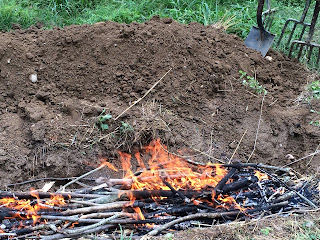Permaculture Design Education at the
Accokeek Foundation
In March, Permaculture Design Certificate Course participants studied Natural Building and Passive Solar Energy among other topics. We built a cold frame and a worm bin, covered a hoop house, planted cover crops at our Persimmon guild and made Biochar, an ancient soil amendment.
Biochar
Biochar is a kind of charcoal, which converts agricultural waste, or in our case, tree branches, into a valuable soil enhancer, which sequesters carbon and can remediate contaminated soil. Native peoples of the Amazon River basin used this “Terra Preta” for hundreds of years to produce dark fertile agricultural soil. It can be made by using a home-made kiln with metal drums, or by lighting a fire to organic material at a garden bed, then burying it with soil to remove the oxygen and hold in the heat. The baked product is carbon-rich biochar.
Guild Design
Our ongoing course project is an Asian Persimmon Guild. A plant guild mimics the interdependence of naturally occurring plant communities of plants/trees, insects, and animals, which benefit each other to accumulate nutrients control pests, provide shelter or shade, and reduce root competition. Many indigenous cultures have farmed sustainably for centuries with agricultural guilds.
The “3 Sisters” guild of pole beans, corn and squash is a common Native American example. Corn provides a scaffold for the bean vines. Beans provide nitrogen for the corn. The large squash leaves shade and protect the soil as a living mulch, inhibit weeds, and keep the soil moist and cool. These mutually beneficial relationships produce higher crop yields, with less water, and no fertilizer, in smaller square footage, than if any of the 3 crops were planted independently.
Following the indigenous model, a Permaculture guild is a highly productive artificial assembly of useful native and non-native plants. It is designed to provide food, herbs, pest control, pollination, and restore soil, while reducing the gardner’s labor and eliminating the need for chemical pesticides, herbicides and other synthetic additives.
In the fall we sheet-mulched our site and planted the self-pollinating Persimmon in the center with a Southern Bayberry wind buffer. This month we prepared the site further with these functional bulbs and cover crops:
- Daffodil - at the future drip line as a “fortress plant” to suppress grass and repel rodents
- Daikon Radish - breaks up compacted soil, edible
- Fava Bean - fixes nitrogen, edible, poultry forage
- Dutch White Clover - Ground cover; fixes nitrogen; attracts beneficial insects - lady bug, minute pirate bug, and lacewing
This month we started perennial seedlings to add to the guild when the weather warms in May. These plants provide food, fiber, medicine, attract beneficial insects, repel pests, fix nitrogen and/or accumulate minerals in the soil:
- Yarrow - mines copper, potassium and phosphorus; attracts lady bugs, hoverfly, lacewing and parasitic wasp
- Sorrel - edible; mines calcium, iron, potassium and phosporus
- Bronze Fennel - culinary herb; attracts lady bug, hoverfly, parasitic wasp and lacewing
- Flax - fiber for cloth; mines manganese, iron and potassium
- Lemon Balm - tea; medicinal/culinary herb; repels voles and rabbits; mines phosphorus; attracts tachinid fly, hoverfly and parasitic wasp
- Salad Burnett - edible salad green; mines sulfur, calcium and magnesium
- Good King Henry - perennial vegetable (like spinach), standing biomass
Stay tuned for the next phase of our Asian Persimmon Guild and other course projects!
- Patricia Ceglia
Save the Dates:___________________________
Accokeek Foundation 3400 Bryon Point Road, Accokeek, MD 20607 accokeekfoundation.org
OBSERVATION & SITE ASSESSMENT WORKSHOP
Sunday, April 30, 2017
1:30 to 4:00 PM
It’s time to plan your garden or take it to the next level! Bring photos, a site plan/survey, google map, sketch, or measurements of your space/garden, along with your imagination.
Learn how to maximize the productivity of your site by observing and analyzing your site for natural resources and unique
characteristics. Design your garden based on Permaculture principles and select appropriate perennial plants. This workshop is suitable for any urban, suburban or rural property, residential, public, or educational situation. If you attended our Winter Garden Planning Workshop, this one will tag onto it. If not, you can start at the beginning.
Held at the Education Center and on-site. Come appropriately attired and prepared for spending time outdoors. Space is limited so register now!!!
REGISTRATION: $30; $25 Accokeek Foundation members
RSVP: design@patriciaceglia.com
RSVP: design@patriciaceglia.com
 |
2016 Permaculture Design Certificate Course graduate, Olivia Canfield presents her suburban homestead design.
|
Certificate Course
STUDENT DESIGN PRESENTATIONS & POTLUCK
STUDENT DESIGN PRESENTATIONS & POTLUCK
Sunday, May 21, 2017
11am - 3:00pm
Come see our students' innovative designs. Each has created a Permaculture plan for a real site, applying the principles and strategies learned in our current certificate course. There will be a variety of urban, suburban & rural sites, residential & farms.
Drop in any time. We will break for a 50-mile Potluck lunch at 1:00pm! Please bring a dish with ingredients sourced within 50 miles of your home. This exercise not only supports local agriculture, but also demonstrates how we can all get involved in local food security.
Held at the Education Center.
FREE!
RSVP: design@patriciaceglia.com
RSVP: design@patriciaceglia.com
"Accokeek" is Algonquin for "Land of the Wild Fruit." Hike the trails by the river, tour the heritage livestock and the National Colonial and Ecosystem Farms, before or after your event.



